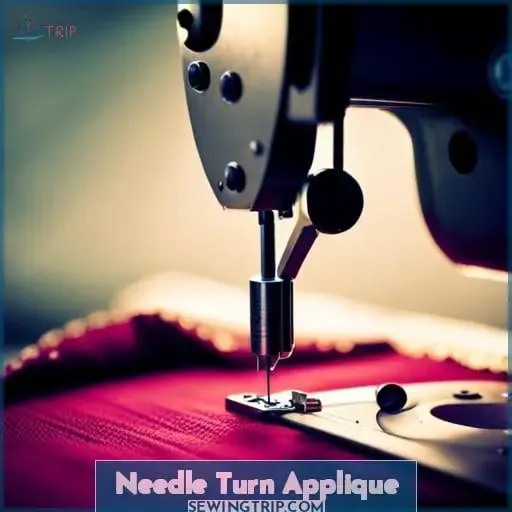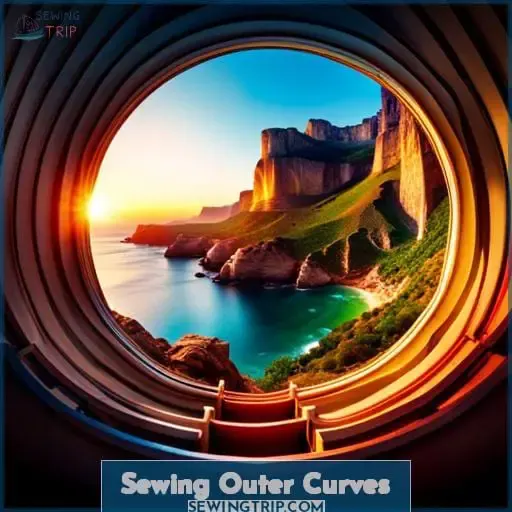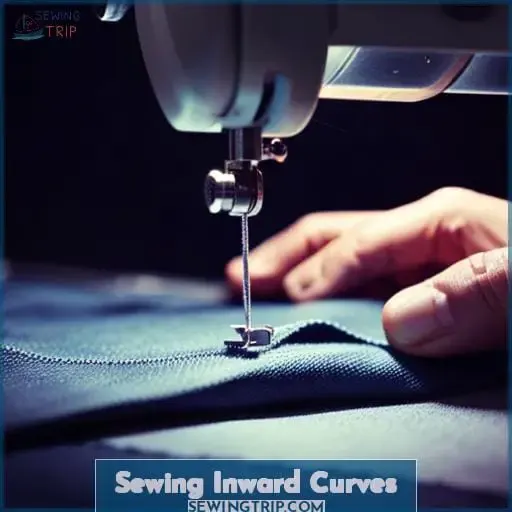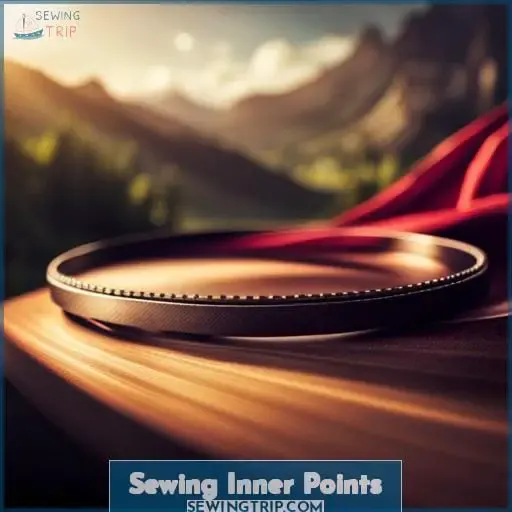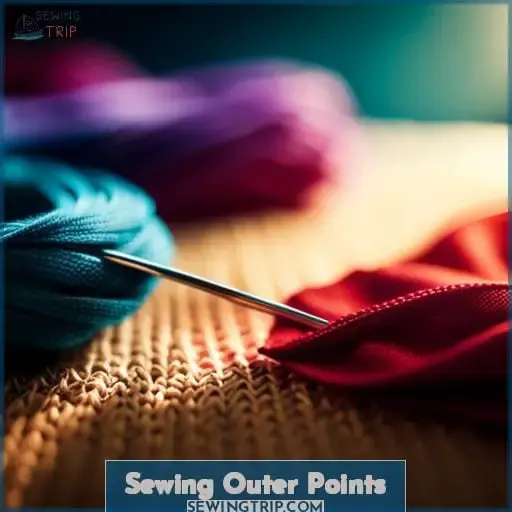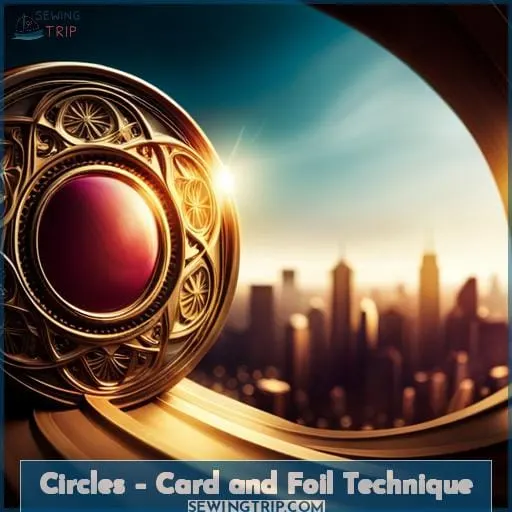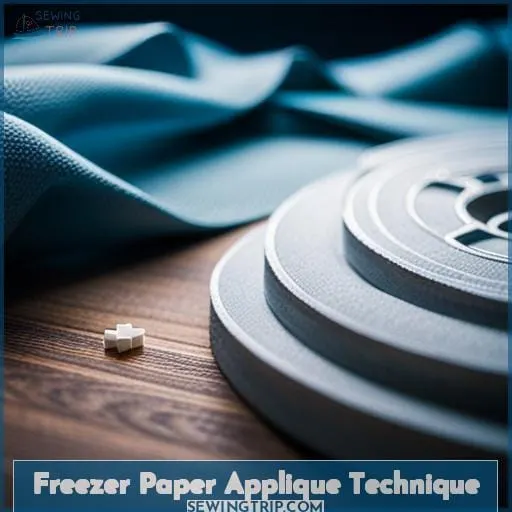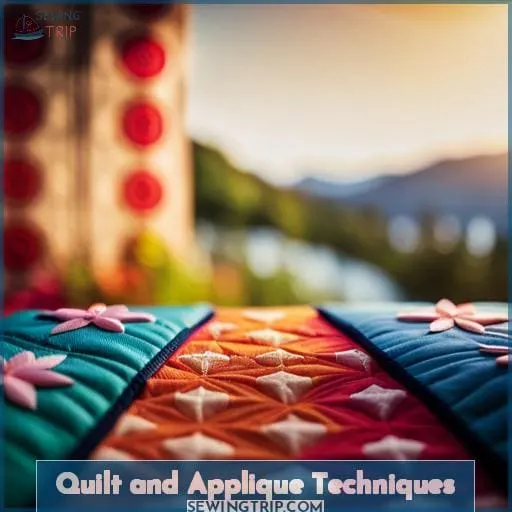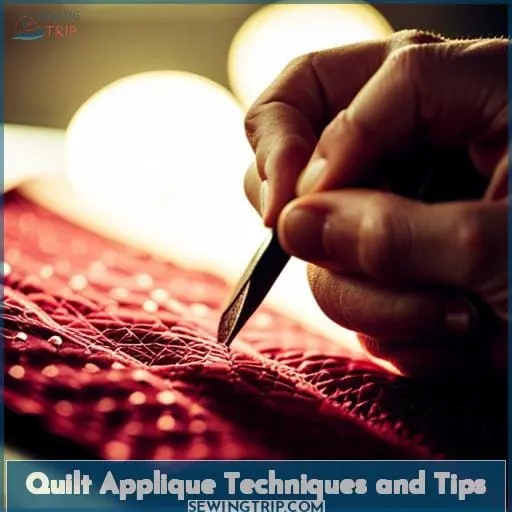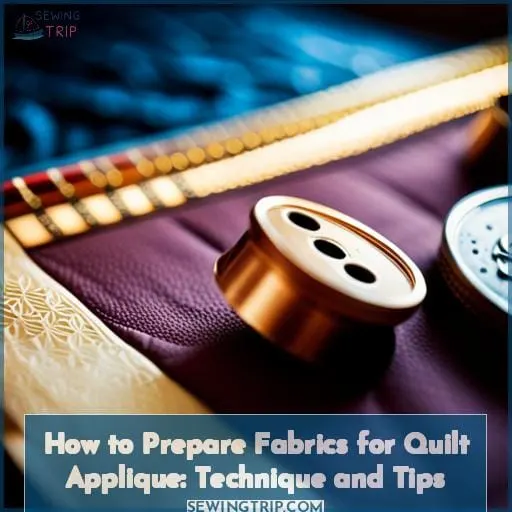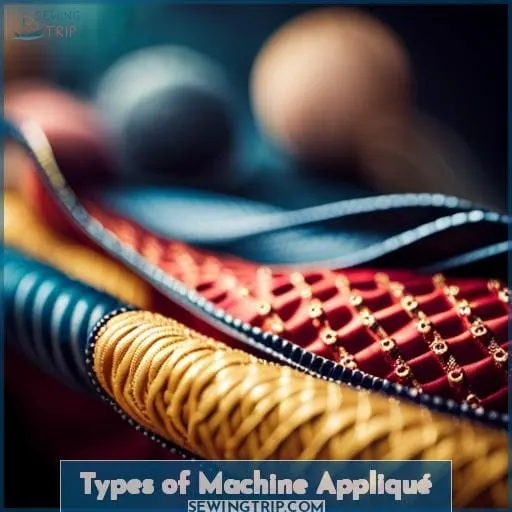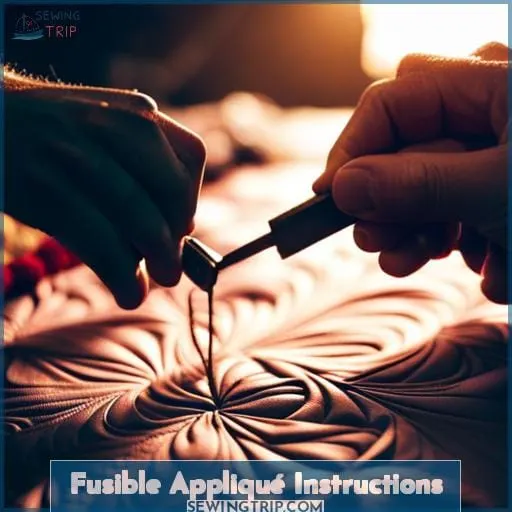This site is supported by our readers. We may earn a commission, at no cost to you, if you purchase through links.
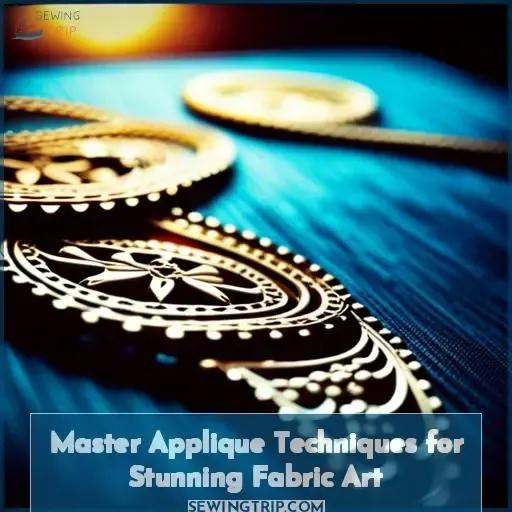 Quilting is a rhythmic dance of needle and thread, a harmonious fusion of fabrics.
Quilting is a rhythmic dance of needle and thread, a harmonious fusion of fabrics.
Appliqué, a radiant jewel in this tapestry, invites you to weave your creativity into stunning fabric art.
With each delicate stitch, you’ll transform ordinary cloth into an extraordinary masterpiece, a testament to your artistry and love for the craft.
As you master appliqué techniques, you’ll discover a world of endless possibilities, where your imagination knows no bounds.
Table Of Contents
- Key Takeaways
- Applique Techniques
- Needle Turn Applique
- Sewing Outer Curves
- Sewing Inward Curves
- Sewing Inner Points
- Sewing Outer Points
- Sewing an Acute Outer Point
- Circles – Card and Foil Technique
- Circles – Card and Gathering Technique
- Freezer Paper Applique Technique
- Quilt and Applique Techniques
- Quilt Applique Techniques and Tips
- How to Prepare Fabrics for Quilt Applique: Technique and Tips
- Stitchin’ Heaven
- Types of Machine Appliqué
- Fusible Appliqué Instructions
- Frequently Asked Questions (FAQs)
- Conclusion
Key Takeaways
- Appliqué can be done with a variety of techniques, including fusible web appliqué, needle-turn appliqué, and freezer paper appliqué.
- There are different techniques for sewing curves, points, and circles when appliquéing.
- Quilt and appliqué techniques include hand quilting, machine quilting, free-motion quilting, and longarm quilting.
- Fabric preparation and stitching techniques include fabric pre-treatment, starching techniques, pressing methods, and seam allowances.
Applique Techniques
Starting with fusible web applique, you’ll create a double-sided adhesive web onto the appliqué shape by tracing the motif onto the papery side of the fusible web, leaving extra space around the shape.
Then, you’ll place the rough-cut shape onto the wrong side of the motif fabric, press the paper side, and allow it to cool.
Next, you’ll cut around the shape through the paper and fabric, peel away the paper, and fuse the motif to the background fabric.
Finally, you’ll stitch around the edge of the shape by machine or hand, creating a beautiful and intricate design.
Needle turn applique is another technique that involves using a hand sewing technique that uses the needle’s tip to turn or stroke the seam allowance around a shape inwards.
You’ll use fine, strong thread and a sharp needle to draw around the template onto the right side of the fabric, adding a scant 1/4” seam allowance.
Then, you’ll secure the shape onto the background using pins, tacking/basting, or tiny dots of washable basting glue before sliding the needle through the back of the appliqué motif and directing it to the wrong side of the seam line, hiding the knot.
Needle Turn Applique
Now you’ll explore a hand sewing technique that uses the needle’s tip to turn or stroke the seam allowance around a shape inwards, called needle turn appliqué.
Using fine, strong thread and a sharp needle, it’s a technique that rewards patience with beautiful, precise results.
Imagine the satisfaction of creating intricate designs with the simple, elegant lines of needle turn appliqué.
Feel the pride of mastering the art of curved edge stitching, acute point sewing, and the gathering circle technique.
Experience the joy of transforming ordinary fabric into stunning works of art.
Embrace the challenge of learning a new skill and the fulfillment of creating something truly unique.
Share the beauty of your appliqué creations with the world and inspire others to explore their own creativity.
With a little practice, you’ll be creating stunning appliqué designs that will add a touch of elegance and charm to your quilts, clothing, and home décor projects.
Sewing Outer Curves
To handle outer curves, smooth the fabric edge under using the needle tip.
If you feel there’s uneven seam allowance or fabric gathering, trim the seam allowance a bit.
Employ small, straight, and close together running stitches on the back of your work.
Once the appliqué motif is sewn, secure and knot off the thread on the back of your work.
Sewing outer curves can sometimes be tricky, but with a little practice, you’ll be able to create smooth, even curves that will add a touch of elegance to your appliqué projects.
Experiment with different stitch lengths and blind stitches to create unique and interesting effects.
You can even use a curved seam allowance to create an outer point.
Just sew a straight line from the outer edge of the curve to the point, then trim the seam allowance and turn the fabric under.
With a little creativity, you can use outer curves to add a touch of personality to any appliqué project.
Sewing Inward Curves
With your seam allowance clipped along the inner curve, you’ll swing the fabric edge under in one sweeping motion with the needle.
Visualize the needle as a graceful dancer, gliding effortlessly along the fabric’s edge, coaxing it into a smooth, inward fold.
Using curved seam allowance, you’ll clip the seam allowance along the inner curve in small cuts, stopping just before they reach the marked seam line.
Picture yourself as a meticulous surgeon, making precise incisions to ensure the fabric’s integrity.
To trim the seam allowance, cut almost to the seam line at the base of the point.
Envision the seam allowance as a delicate petal, and your scissors as a skilled gardener, carefully shaping it into its final form.
Use the needle to swing the seam allowance towards you, turning the seam under at the point and beyond.
Imagine the needle as a tiny paintbrush, painting an intricate design onto the fabric, one stitch at a time.
Hold the turned seam allowance in place with your non-stitching hand and stitch with close together stitches, stopping just before the base of the point.
Feel the rhythm of the needle and thread as they create a secure and beautiful seam.
Sewing Inner Points
After clipping your seam allowance, use the tip of your needle to swing the fabric edge under, turning the seam under at the point and beyond.
Imagine the needle as a delicate paintbrush, carefully guiding the fabric into place, like a ballerina gracefully twirling on stage.
Hold the turned seam allowance in place with the thumb of your non-stitching hand, and sew with close-together stitches, stopping just before the base of the point.
To create a crisp and precise inner point, trim the seam allowance so that the cut almost reaches the seam line at the base of the point.
With the needle, swing the seam allowance towards you, turning the seam under at the point and beyond, ensuring a smooth and seamless transition.
This hand sewing technique requires patience and attention to detail, but the result is a stunning appliqué with perfectly executed inner points that add a touch of elegance and sophistication to your fabric art.
Sewing Outer Points
Now that you’ve mastered sewing inner points, let’s move on to tackling outer points for a complete appliqué experience.
Appliqued sharp outer points add a dynamic touch to your fabric art, drawing the eye and creating a sense of dimension.
To machine stitch outer points, begin by marking the seam allowance on the wrong side of the fabric. Stitch along the marked line, stopping just before the point. Carefully trim the seam allowance close to the stitching, leaving a small triangle of fabric at the point.
Using the tip of your iron, press the seam allowance open, pushing the point outward. Fold the seam allowance to the wrong side along the pressed crease, mitering the corners if necessary.
With patience and precision, you can achieve crisp and clean outer points that elevate your appliqué designs.
Experiment with different fabrics and colors to create stunning visual effects. The possibilities are endless, so let your creativity soar!
Sewing an Acute Outer Point
Your needle’s tip swings the acute outer point’s seam allowance under smoothly.
The fabric molds perfectly, conforming to your skillful guidance.
The needle’s tip gently guides the seam allowance, tucking it neatly into place.
With careful precision, you stitch along the angled point, ensuring each stitch is secure.
Your fingers deftly maneuver the fabric, keeping it taut and flat as you sew.
Reinforce the point with a few extra stitches, adding strength and durability to your appliqué.
The acute outer point is now complete, a testament to your expertise and patience.
Circles – Card and Foil Technique
Carrying on with circles, you’ll use a card template and foil to turn the seam allowance inwards, creating a clean and precise finish.
Begin by placing the card circle template on the wrong side of your fabric and drawing around it.
Cut a square of foil, place the fabric circle right side downwards, and the card template on the wrong side of the circle.
Wrap the edge of the foil over tightly so the fabric and the foil turn towards the center of the circle template, smoothing the edges as you go.
Use a warm iron to gently press the foil-wrapped edge of the circle, allowing it to cool before unwrapping the foil.
The seam allowance will now be turned in ready for sewing, giving your appliqué motif a polished and professional look.
Circles – Card and Gathering Technique
With the card and gathering technique, you’ll create a circle shape by stitching around the edge of a card template and gathering the fabric underneath.
This method is perfect for creating circles of any size, and it’s a great way to secure appliques to your project.
-
Trace and Cut:
- Trace the circle template onto the fusible web and cut it out.
- Iron the fusible web onto the wrong side of the fabric, then cut out the circle.
-
Gather and Stitch:
- Place the circle of fabric right side up on the card template.
- Stitch around the edge of the template, using a gathering stitch.
-
Pull and Secure:
- Gently pull the gathering stitches to gather the fabric.
- Secure the stitches by knotting them together.
-
Fuse and Applique:
- Place the gathered circle onto the background fabric, right sides together.
- Fuse the circle in place, then stitch around the edge of the circle to secure it.
Freezer Paper Applique Technique
How can you use freezer paper to create crisp and accurate appliqué shapes?
Begin by printing and tracing your desired appliqué design onto freezer paper.
Cut out the design, leaving a quarter-inch seam allowance.
Iron the paper side of the freezer paper onto the wrong side of your fabric.
Cut out the fabric shape, following the freezer paper outline.
Peel away the freezer paper to reveal the fusible side of the fabric.
Arrange the fabric shape onto your background fabric and press it in place with an iron.
Stitch around the appliqué shape by hand or machine, using a small stitch length.
Once the appliqué is stitched in place, carefully tear away the freezer paper.
The freezer paper appliqué technique is perfect for creating intricate designs with curved shapes, making it a versatile method for both beginners and experienced quilters.
Quilt and Applique Techniques
Now that you’ve seen several appliqué techniques, let’s compare hand and machine quilting.
Hand quilting is an excellent option for small projects, while machine quilting is better for larger quilts.
Both have their own unique advantages and disadvantages, so the best choice for you will depend on your individual needs and preferences.
Quilting Styles
Embark on a quilting adventure, exploring diverse styles:
- Hand and machine quilting
- Free-motion’s fluidity
- Longarm’s precision
Craft unique fabric art with your choice of:
- Designs
- Fabrics
- Colors
- Appliqué patterns
Hand Quilting
Hand quilting, a time-honored technique, guides stitches with a quilting hoop, bringing fabric pieces together with the warmth of your own hands.
Machine Quilting
With machine quilting, you’ll automate your quilting process to save time.
Enjoy the convenience of:
- Rapid stitching
- Consistent patterns
- Enhanced precision
Free-Motion Quilting
Following machine quilting,
you’ll dance with free-motion quilting’s liberating artistry,
painting unique patterns and textures onto your appliquéd fabric canvas.
| Free-Motion Quilting Motifs | Free-Motion Quilting Fabric Art | Stunning Free-Motion Quilting |
|---|
Longarm Quilting
Try longarm quilting for larger quilts and projects that require a broader quilting surface.
Longarm quilting machines offer a larger quilting space, allowing you to tackle larger projects with ease.
Quilt Applique Techniques and Tips
Kick off your appliqué journey by embracing the Freezer Paper Method for precise templates.
Try your hand at Hand Appliqué for intricate designs.
Explore Fused Appliqué for quick and easy embellishments.
Freezer Paper Method
Moving on to the freezer paper method, you’ll explore how to use freezer paper as a stabilizer for creating precise appliqué shapes.
- Iron freezer paper onto the wrong side of the fabric.
- Cut out the appliqué shapes, leaving a seam allowance.
- Peel away the freezer paper, leaving the fusible adhesive behind.
- Position the appliqué shapes onto the background fabric.
- Press to fuse the appliqué shapes in place.
Hand Applique
With hand appliqué, you’ll create fabric designs with a needle and thread, exploring endless possibilities for unique and intricate art.
Hand Applique Basics:
- Stitch fabric pieces together by hand.
- Use a variety of stitches for different effects.
- Create intricate designs with ease.
Needle Turn Applique Basics:
- Fold fabric edges under and stitch in place.
- Use a blind stitch for a seamless finish.
- Perfect for beginners and experienced quilters alike.
Fused Applique
Next, master fused appliqué, where fabric shapes are ironed onto the background fabric.
Enjoy non-stitching handwork with folded edge appliqué patterns for creative fused appliqué projects.
Raw-Edge Applique (Using Flower Motifs)
By fusing fabric flower motifs onto the quilt background with fabric glue, create a raw-edge appliqué design.
Explore unique flower motif placement and embrace the raw edge as a design element.
Turned Edge or Basting Applique Method
- Trace the layout onto the proper facet of the applique fabric using your trusty pencil.
Flip the fabric, trace, and cut out the motif with a scant 1/4” seam allowance.
Hand sew a running stitch along the seam line, leaving long thread tails.
Gather the fabric gently, easing in any fullness, and secure the gathers.
Fold the seam allowance to the wrong side, encasing the raw edge, and secure with a slip stitch.
Press the turned edge applique to create a smooth, professional finish.
How to Prepare Fabrics for Quilt Applique: Technique and Tips
As you embark on your quilt applique journey, the significance of meticulous fabric preparation can’t be overstated. This crucial step sets the stage for successful applique and ensures your final masterpiece exudes professionalism and finesse.
Fabric Pre-Treatment:
- Begin by pre-washing your fabrics to eliminate sizing and impurities that might hinder the applique process.
-
This ensures optimal adhesion and prevents puckering or distortion.
Starching Techniques:
- Starch your fabrics appropriately to provide stability and prevent fraying.
-
Experiment with different starching methods, like spray starch or liquid starch, to find the one that best suits your fabric and project.
Pressing Methods:
- Master the art of pressing your fabrics to achieve crisp edges and flat surfaces.
-
Utilize a pressing cloth to protect delicate fabrics and prevent shine.
Seam Allowances:
- Carefully consider seam allowances when cutting your fabric pieces.
- A consistent seam allowance ensures uniformity and facilitates precise stitching.
These preparatory steps may seem like minor details, but they hold immense power in elevating your applique projects to the next level. Embrace these techniques and witness the transformative effect they’ve on your fabric art.
Stitchin’ Heaven
Stitchin’ Heaven, located in Quitman, Texas, is your premier destination for all your quilting and sewing needs. Our expansive 17,500-foot facility is an independent, family-owned shop passionate about providing the highest quality fabrics and supplies.
We offer an extensive selection of over 10,000 unique fabrics, ensuring you’ll find the perfect materials for your next project. Our friendly and experienced staff is always ready to assist you with your project, offering expert advice and guidance.
Shop from the comfort of your own home and have your order shipped directly to your door through our online destination. Join our vibrant community of quilters and participate in our workshops and classes to learn new techniques and share your passion for the craft.
We’re committed to providing you with an exceptional shopping experience, ensuring you’re completely satisfied with your purchase.
Types of Machine Appliqué
Now, let’s explore the world of machine appliqué techniques:
- Raw-edge appliqué: Fabric edges stay raw and are sewn inside.
- Freezer paper appliqué: Freezer paper is used as a template.
- Reverse appliqué: Fabric is removed to reveal a design.
You’ll discover a variety of methods to create stunning fabric art.
Raw-edge Appliqué
First, fuse your raw-edge appliqué onto your background fabric using fusible web or fabric glue.
Unleash your creativity by experimenting with various materials and fabric combinations.
Embellish your appliqué with decorative stitches for a unique touch.
Freezer Paper Appliqué
Using freezer paper appliqué, stitch fabric pieces to a background with a clean, fused edge.
Trace motifs onto freezer paper, iron onto fabric scraps, cut out, peel away paper, and stitch in place.
This technique is perfect for precise appliqué designs, as the freezer paper stabilizes the fabric and prevents fraying.
Reverse Appliqué
Reverse appliqué lets you layer fabrics and reveal designs by cutting and stitching.
Picture this: intricate patterns emerge from contrasting fabrics, creating stunning visual depth.
Experiment with reverse appliqué fabric and designs to craft unique quilts and fabric art.
Explore bias tape and quick-turn appliqué techniques to add dimension and texture to your work.
Fusible Appliqué Instructions
Next, let’s explore fusible appliqué:
- Print templates, trace them onto freezer paper, and cut out the shapes.
- Press fabric scraps to HeatnBond and layout the freezer paper templates before pressing.
- Prepare your machine with a clear appliqué presser foot, a new needle, and the appropriate settings.
You Will Need
To follow these fusible appliqué instructions, you’ll need:
- A clear appliqué presser foot
- A new needle
- A wound bobbin
| Tool | Purpose |
|---|---|
| Clear appliqué presser foot | Ensures accurate stitching. |
| New needle | Prevents skipped stitches and fabric damage. |
| Wound bobbin | Provides a smooth thread flow. |
Step 1: Preparing Your Appliqué
Let’s begin by printing templates on plain printer paper.
Trace them onto freezer paper and cut them out.
Iron fabric scraps to HeatnBond and arrange freezer paper templates on them.
Press, cut each template shape, remove freezer paper and HeatnBond paper backing.
Prepare your machine with an appliqué presser foot, new needle, bobbin, and zig-zag stitch width.
Mark curved appliqués in 1/4 to 1/2 increments.
Step 2: Preparing Your Machine
Next, set up your machine for appliqué.
Install a clear appliqué presser foot and a new needle.
Wind a new bobbin and set your machine to appliqué settings.
Test your zig-zag stitch width to ensure it’s perfect for your project.
Step 3: Sewing Your Appliqué
- Position your appliqué shiny side down and press it.
Align the center mark with the appliqué’s edge, and begin stitching with a zigzag stitch using a clear appliqué presser foot.
Follow the freezer paper method and machine appliqué settings to sew your appliqué securely onto the fabric.
Frequently Asked Questions (FAQs)
What are the advantages and disadvantages of using fusible web appliqué compared to needle turn appliqué?
Fusible web appliqué offers swift application and precise shapes.
However, its stiffness may limit intricate designs.
Needle turn appliqué grants artistic freedom with flowing curves.
But it demands patience and steady hands.
Your choice depends on the desired look and your skill level.
How do you handle curves when using the freezer paper appliqué technique?
When curves arise in your freezer paper appliqué journey, wield your scissors like a skilled surgeon, snipping precisely along the seam’s inner curve.
Let your needle be your paintbrush, guiding the fabric’s edge in a sweeping motion, like a dancer twirling on stage.
What are some tips for sewing inner points when using the needle turn appliqué technique?
When navigating inner points with needle turn appliqué:
Make tiny cuts along the seam allowance.
Swing the fabric under with your needle.
Stitch closely, securing the turned seam allowance with your non-stitching hand.
How do you prepare fabrics for reverse appliqué?
Prepare fabrics for reverse appliqué by embracing the art of subtraction.
Remove sections of fabric to reveal the hidden beauty beneath, creating a captivating interplay of layers and textures.
Unleash your inner artist and let the fabrics themselves guide your design.
What are some creative ways to use appliqué in quilting projects?
Incorporate appliqué into your quilting projects to add depth, texture, and personalized touches.
Experiment with various fabrics, shapes, and stitching techniques.
Create unique and eye-catching designs that reflect your creativity and style.
Conclusion
As you embark on your appliqué journey, let your creativity flourish like a garden bursting with colorful blooms.
With each stitch, you’ll transform simple fabrics into stunning works of art, adding a personal touch to your quilts and home décor.
The appliqué techniques you’ve learned will empower you to create heirloom-quality pieces that reflect your unique style and artistry.
So, keep stitching, keep exploring, and let your appliqué passion shine through.

